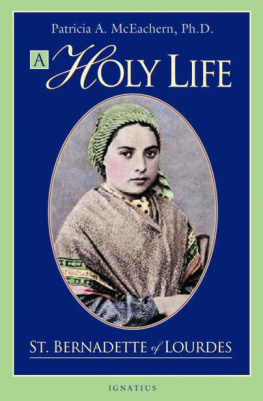

This edition is published by PICKLE PARTNERS PUBLISHINGwww.pp-publishing.com
To join our mailing list for new titles or for issues with our bookspicklepublishing@gmail.com
Or on Facebook
Text originally published in 1957 under the same title.
Pickle Partners Publishing 2016, all rights reserved. No part of this publication may be reproduced, stored in a retrieval system or transmitted by any means, electrical, mechanical or otherwise without the written permission of the copyright holder.
Publishers Note
Although in most cases we have retained the Authors original spelling and grammar to authentically reproduce the work of the Author and the original intent of such material, some additional notes and clarifications have been added for the modern readers benefit.
We have also made every effort to include all maps and illustrations of the original edition the limitations of formatting do not allow of including larger maps, we will upload as many of these maps as possible.
SAINT BERNADETTE SOUBIROUS: 1844-1879
BY
ABB FRANOIS TROCHU
TRANSLATED AND ADAPTED BY JOHN JOYCE, S.J.

But blessed are your eyes, because they see, and your ears, because they hear. For, amen, I say to you, many prophets and just men have desired to see the things that you see, and have not seen them, and to hear the things that you hear and have not heard them. Matt. 13:16-17
TABLE OF CONTENTS
Contents
LOURDES, TOWN OF DESTINY
Lourdes already existed in the earliest days of the Christian era. Originally a large village, inhabited by peaceable Bigourdans but perilously set on the threshold of the Pyrenean valleys, it knew many a foreign occupation. After Caesars conquest of Gaul, the Roman eagles were set up there; the Pont-Vieux across the Gave dates from that time. There followed Visigoths, Saracens, Franks....It is with the Saracen occupation that the story of Lourdes begins to merge into the story of Our Lady on French soil.
In 732 Charles Martel, by his victory over the Saracens, halted the advance of Islam upon Christian civilization. The enemy fled toward Spain. Nevertheless, some groups of the conquered held out in the fortresses of Aquitaine, of which one was the castle of Mirambel on the rock overhanging Lourdes. In 778, Charlemagne, wearily returning from his expedition to Spain, attacked the garrison whose commander, the implacable Mirat, had sworn by Mahomet that he would not surrender to any mortal man.
The fortress seemed absolutely impregnable; it could only be starved into surrender. The siege was desperately prolonged. Then one day an eagle, carrying a trout caught in the Gave, let it fall inside the Saracen walls. Immediately the cunning Mirat sent off the still floundering trout to the besieger, as though it were merely an unwanted addition to the plentiful rations of his soldiers. So, it seemed, the supplies of the fortress were inexhaustible! Charlemagne began to despair of victory and spoke of raising the siege.
But, so the story runs, Roracius, Bishop of Le Puy and chaplain to the Frankish army, had scented the trick. He obtained an audience with Mirat and saw for himself that the Saracens were at the end of their resources. Mirat insisted on his oath. Brave prince, replied the bishop, you have sworn never to yield to any mortal man. Could you not with honor make your surrender to an immortal lady? Mary, Queen of Heaven, has her throne at Le Puy, and I am her humble minister there.
Thus, freed from his oath, the Saracen chief came to terms. In token of his vassalage, he agreed to bring to the sanctuary of his Queen some handfuls of grass plucked on the bank of the Gave. Baptized under the name of Lorus, Mirat was knighted by Charlemagne and received from him the command of the fort of Mirambel. It is from Lorus, so the learned assert, that is derived the name of Lourdes.
But over a thousand years were to pass before the sovereignty of the Blessed Virgin was proclaimed in humility, yet with divine power, over the impregnable fortress and the old grey-roofed country town. And that is where the story of St. Bernadette Soubirous begins.

MAPS


ICHILDHOOD
1FROM MILL TO MILL
ON Tuesday, January 9 th , 1844, at St. Peters Church, Lourdes, in the Bigorre, the Dean himself, Abb Dominique Forgue, was baptising a baby girl, the first-born of Franois Soubirous and Louise Castrot, whose wedding had been celebrated in this same church a year ago to the day. Who would have dreamt that the very font to which this child was brought would later be preserved from destruction and be venerated on her account?
She had come into the world two days before, on the Sunday after the Epiphany, about two o'clock in the afternoon, as the bell was ringing for Vespers. She cried the whole time during her Baptism, to the sorrow and disgust of her cousin and godfather, Jean-Marie Vdre, a schoolboy of eleven, whom his parents had brought from Momres, near Tarbes, together with his sister, Jeanne, aged fourteen.
During the ceremony, the Cur kept calling the child Marie-Bernarde, and this was noticed by the father. Back in the Sacristy he pointed out, on the instigation of the godmother, Aunt Bernarde Castrot, that the child had been registered the day before at the Town Hall under the Christian names, Bernarde-Marie. By a happy inspiration, Abb Forgue retained the name Marie-Bernarde in the parish register, as though he had had the deliberate intention of placing the newly born, from the very start, under the protection of the Blessed Virgin. In the event, the godmother obstinately refused to give way; only in a distant future was her godchild to regain her beautiful first name of Marie. In Lourdes, although her name remained Bernarde, she would always be known by the graceful diminutive, Bernadette.
To the joyful sound of the bellsfor in the Bigorre every legitimate child was entitled to a free peal of the bellsthe humble procession went down towards the house where she was born.
This was a mill, called Boly after an English doctor who owned it in the seventeenth century. It was not in appearance one of the smallest of the six mills which stood in echelon to the north of Lourdes along the banks of a tributary of the Gave called the Lapaca. Milling, indeed, took up a large part of the property: there was a store-room for the grain, a room to house the millstones and a shed for the big mill-wheel; only three rooms and the kitchen were reserved for living accommodation.
As they approached the threshold Jean-Marie Vdre, who was walking beside Bernadettes father, pointed to his godchild and remarked in a disappointed tone, She has done nothing but cry; she will be a bad one.
This reflection was lost in the joyful outburst of voices, for as they approached the house they began shouting their greetings to the young Mamma waiting inside for her Bernadette. Shedding tears of happiness this good Christian woman kissed the childs brow first, in reverence for the grace of its Baptism.
Next page


















